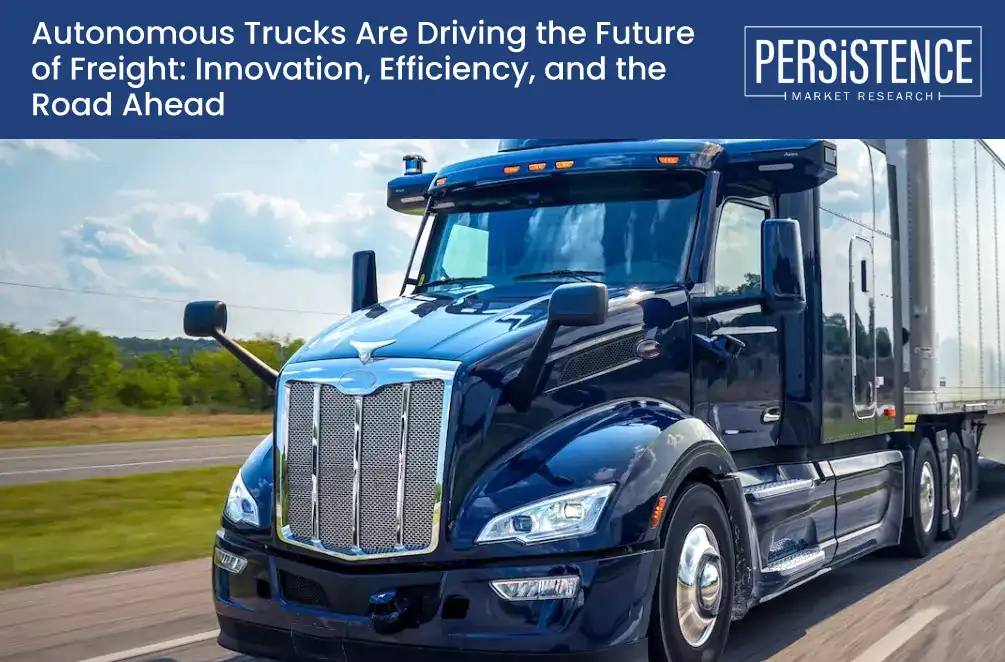- Blog
- Autonomous Trucking Innovations And Trends
Autonomous Trucks Are Driving the Future of Freight: Innovation, Efficiency, and the Road Ahead
Published On : 2 Jul 2025
Autonomous trucks are self-driving vehicles equipped with advanced technologies like AI, sensors, and connectivity systems that allow them to navigate roads with minimal or no human input. These trucks range from semi-autonomous models that assist drivers to fully autonomous ones capable of operating independently across long distances. These trucks promise greater efficiency, lower costs, and a safer future for global supply chains.

How are autonomous trucks classified?
According to SAE guidelines, these vehicles range from Level 0 (no automation) to Level 5 (full automation). The industry currently focuses on Levels 2-3 (semi-autonomous) and Levels 4-5 (fully autonomous). Semi-autonomous trucks still require a human driver for certain tasks, while fully autonomous ones operate independently.
These trucks come in various forms depending on their use case. Long-haul trucks dominate highway routes, while last-mile delivery vans navigate urban environments. The level of automation and operational scope defines their category, with full automation poised to transform logistics for large-scale operators.
What is the autonomous trucks market size and where is it headed?
The autonomous trucks market size is likely to be valued at US$28 bn in 2025 followed with a need for faster, more cost-effective delivery solutions. North America and Europe currently lead the charge, but Asia Pacific is also rapidly gaining ground thanks to upcoming government support and technological investments.
The market’s expansion reflects a broader shift in transportation, where automation is not just a novelty but a necessity for scaling logistics operations efficiently.
Who are the key players and what is the competitive landscape like?
Industry giants such as Tesla, Waymo, TuSimple, and Embark are at the forefront of autonomous trucking innovation. These companies are pouring resources into R&D to enhance safety, reliability, and scalability. Strategic partnerships are crucial. For instance, TuSimple’s collaboration with UPS, for instance, is testing autonomous freight routes to optimize delivery networks.
The competitive landscape is dynamic and innovation-driven, with firms racing to develop cutting-edge solutions and secure market share through alliances and pilot programs.
What drives the growth of autonomous trucks?
Several factors are propelling the market forward. Cost efficiency is a major incentive autonomous trucks to reduce fuel consumption and labor costs. With driver shortages becoming a global issue, automation offers a viable solution. The rise of e-commerce has also intensified the need for rapid last-mile deliveries.
Technological advancements are central to this growth. Enhanced sensors like LIDAR and radar improve safety, while V2X (vehicle-to-everything) communication enables trucks to interact with infrastructure and other vehicles. Government support through grants and favorable regulations further accelerates adoption.
What challenges and restraints do the industry face?
Despite its promise, the autonomous trucking industry faces significant hurdles. Regulatory frameworks are still evolving, creating uncertainty for manufacturers and operators. Safety and cybersecurity are pressing concerns—autonomous systems are vulnerable to hacking and technical failures.
High development costs also pose a barrier. Building and testing these vehicles requires substantial investment, and public skepticism remains. Concerns about job displacement and safety slow down widespread acceptance, making education and transparency vital for progress.
What technologies and innovations are shaping the future?
Autonomous trucks rely on a suite of sophisticated technologies. LIDAR generates detailed 3D maps, cameras interpret road signs and detect obstacles, and radar ensures functionality in adverse weather. AI algorithms synthesize this data in real-time, mimicking human decision-making.
V2X communication is a game-changer, linking trucks to traffic systems and infrastructure for smoother navigation. Infrastructure upgrades, like smart highways, further enhance operational efficiency. Pilot programs such as Kamion’s highway tests in Europe demonstrate the viability of autonomous freight, reducing errors and cutting delivery times.
What does the future hold, and how should stakeholders prepare?
The future of autonomous trucking is bright, driven by continuous advancements in AI and automation. Smarter trucks will adapt to diverse environments, and connected infrastructure will streamline logistics. Companies must invest in R&D and forge strategic partnerships to share technology and reduce costs.
Policymakers play a crucial role in shaping this future. Clear, forward-thinking regulations are needed to ensure safety without stifling innovation. As the industry matures, autonomous trucks promise not just faster deliveries and lower costs, but a fundamental shift in global transportation.
Industry Report

Request Report Sample
Your privacy is important to us; your data is secure
Contact Us
Latest Reports
-
Piezoresistive Pressure Sensor Market by Sensor Type (Absolute, Gauge, Differential, Sealed), Pressure Range (Low Pressure (<10 kPa), Medium Pressure (10 kPa – 1000 kPa), High Pressure (>1000 kPa)), End-Use Industry (Automotive & Transportation, Industrial Manufacturing, Healthcare, Aerospace & Defense, Electronics) and Regional Analysis for 2026-2033
-
Aquarium Accessories Market by Product Type (Filtration Items, Lights & Hoods, Temperature Control Systems, Others), End-User (Residential, Commercial), Distribution Channel (Online, Offline), and Regional Analysis for 2026-2033
-
Oxygen Therapy Market by Product Type (Compressed Oxygen, Concentrated Oxygen, Liquid Oxygen), Disease (Respiratory Disorder, Cardiovascular Disease, Sleep Apnea, Pneumonia), End-User (Hospitals, Home Healthcare, Clinics), and Regional Analysis for 2026-2033
-
Air Curtains Market by Product Type (Non‑Recirculating, Recirculating, Heated, Others), Airflow Capacity (Up to 500 m³/h, 500–1000 m³/h, 1000–1500 m³/h, Above 1500 m³/h), Application (Commercial, Industrial, Residential, Others), and Regional Analysis for 2026–2033
-
Personalized Stationery Market by Product type (Storage & Filling Products, Paper-Based Products, Drawing & Writing Instruments, Accessories, Bags, Others), Application (Educational Institutes, Corporate Offices, Personal Use, Hospitals, Others), and Regional Analysis for 2026–2033
